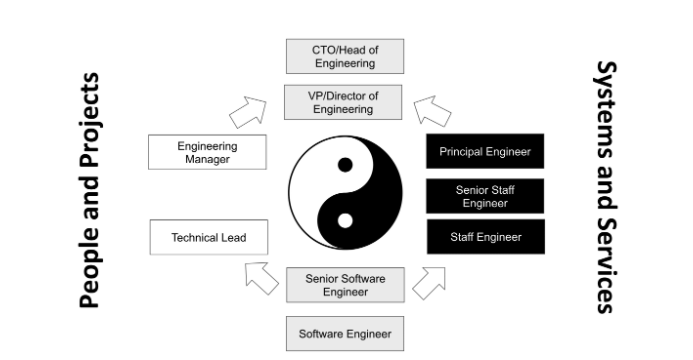How to move up the ladder as a Software Developer
It’s human nature to look to the future and look at where our jobs could lead us and a career in software development is no different. While the progression ladder isn’t as straightforward as other professions, there are two directions developers usually take – Technical or People. Both options provide a challenging direction for developers but require a lot of preplanning and reflection to ensure they follow the right path. When deciding which route to pursue it is important to consider what aspects of your role you enjoy and what where your strengths lie.
It is important to note that you must be performing well in your current role before thinking about progression. If you can demonstrate that you can excel in your current responsibilities, it builds trust that you can move to a role with more responsibility. However, some companies lack progression opportunities or promotion timelines are too slow. From my recruitment experience, progression is the most common reason why people look at new opportunities. It is important to realise whether there is opportunity or not and, if not, be ready to move on to achieve your ambitions.

(Image credit: Kashif Razzaqi via Springboard)
Plan a career path/ Establish career goals
Moving up the ladder isn’t something that happens overnight, the most successful people in software development meet individual goals in order to get to the top. First you must look at what direction you want to go down – perhaps this is doing some mentoring to understand if you’d like to work in a people management role. You must look at what level you want to aim for and how to get there – if you want to be a CTO perhaps you could look into at a Master’s Degree in Technical Leadership. A big part of planning is to be realistic, no point selecting unmanageable timelines, or you will be setting yourself up to fail. You must look at what you want to achieve and where you want to be in 1, 2. 5 and 10 years.
Below is a typical career path of a Software Developer:
_.jpg)
(Imgae credit: Springboard)
This highlights a realistic timeline in years and how the roles will differ as you move up the ladder. This path moves towards people management with an emphasis on motivating others to deliver technically as opposed to being technically hands-on yourself. Although it is important to understand that you can excel in a technical role without having to transition into people management.
Direction
When deciding to move up the ladder it is important to determine whether you want to remain on the technical side or move to more of a people management role. Both are great options and it’s really about personal preferences. Are you a Steve Jobs or a Steve Wozniak? An Interesting thing to note is that software development is one of the few professions that Engineers can earn more than their line managers. Take for example a Principal Engineer who is an expert in his company’s software solutions. His skillset is going to be more valuable to the company than a people manager, therefore he can warrant a higher wage.
Maximising Chances of Promotion
To gain promotions it is vital that developers recognise opportunities. Are there organic opportunities from a scaling company or is someone leaving or retiring who needs to be replaced? By identifying opportunities, you can position yourself to have the best chance of taking them. First things first, it’s important to demonstrate interest and motivations to be in management. You can share your aims and goals during one to one’s and performance reviews. Ideally you want to telegraph your intentions to your boss.
Next you want to highlight to management that you are ready to make the transition, whether this is towards people management or a more technical role it is vital to highlight you are capable. Asking for regular feedback, watching role models, learning from mentors, and mentoring others are ways of preparing yourself. If looking for more technical responsibilities it is important that you are excelling in your current role and keep on top of modern tech stacks.
If you want to transition towards a people management position, it is important to understand the agile process, get agile training, train others and develop leadership qualities. I would encourage people to get more involved with strategic decisions like volunteering to be part of interview panels. Regardless of direction you must convince management that you can train in a replacement to effectively deliver on your responsibilities if you are to move up the ladder.
Transition
The transition during a promotion is one of the hardest parts of moving up the career ladder as you will be taking a leap into new responsibilities, so you must be prepared. It’s now not just about hard work and attention to detail as you will have more in depth technical or management responsibilities. By choosing the people management path you will be going from command line to line of command and must know that there are no product specs or algorithms for people. You must realise that a manager must make tough decisions, give critical feedback and may not win a lot of friends.
90% of a manager’s role is influencing others, rather than doing it themselves and to some this will be a major career change. You will transition from debugging software to debugging teams. In a more senior position, it is important to think about how you present yourself – if you want to be in a particular position, start to look and act like it. Another thing that can be difficult is handing over control especially if you have invested a lot of time into a project or solution. What you must realise is that you cannot do everything and as a leader you can guide and coach others to keep high standards. Relationships can similarly be affected by promotions as you may be managing previous teammates, it is important that you demand their respect while remaining professional.
Promotions and transition aren’t always what people want and within software development we have ‘forever developers’. If you are happy with what you do you don’t have to change, in fact many contractors have built up solid reputations for their technical delivery as engineers. Developers who have become experts using a tech stack can warrant higher salaries or daily rates as they can hit the ground running without any training or mentorship.
Qualifications
Additional qualifications are not required to move up the career ladder but can be helpful for you to stand out. On the technical side it will be important to stay up to date with the latest development versions, frameworks and cloud. For example, a Frontend Developer might want to do a React course to ensure they are well versed in React and can deliver high level solutions. Others may decide to do a Master’s in Computer Science so they can revisit development at an advanced level which will aid them solving more difficult technical problems or complete an Azure Certification to expand their cloud knowledge. With people management aspirations, developers may consider some agile training or look at Master’s degrees in Management or Leadership. What is certain is that to move up the ladder you must be ambitious and have a thirst for learning.
Moving up the ladder is not an easy task and requires dedication, planning and perseverance. The reality is the people with the top jobs within software development didn’t get there overnight and have worked hard to get to where they are today. By selecting the right direction, expanding knowledge, and demonstrating the right attitude, developers can move into more senior roles quickly and take on more responsibility. To look at the salaries associated with the different steps on the software development ladder, check out our Salary Guide. You will see ranges from Senior Developer to CTO.
Evaluating opportunities is an essential part of a successful career plan, without room to grow moving up the ladder can be difficult and frustrating. Identifying organic growth opportunities can help you transition up the ladder, but your boss must approve. When looking for progression you must evaluate if your current company can meet your aspirations and if not, you should move to a company that can.
If you have hit a ceiling in your current company and are looking for a new position to move up the ladder, why not browse through our list of our .NET Software Development jobs. While making this transition it is key to create a CV that outlines all your experiences and sets you up well for your job search. You can check out our CV template example, to gain a bit of guidance on this. If you want some advice on how to grow your team or get some insights into setting up a progressive environment for your developers reach out to me at cathal.mcaliskey@gempool.ie or go to our services page.

